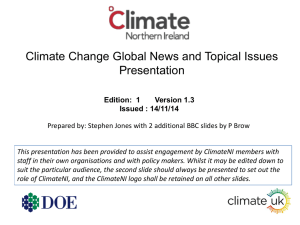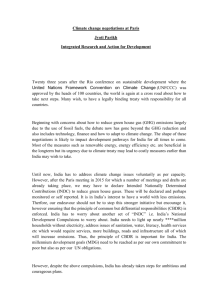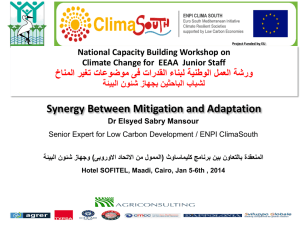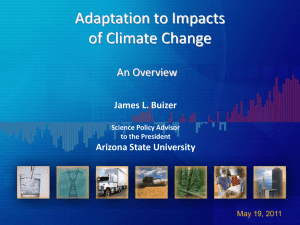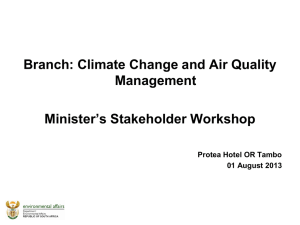Mazmanian Presentation
advertisement
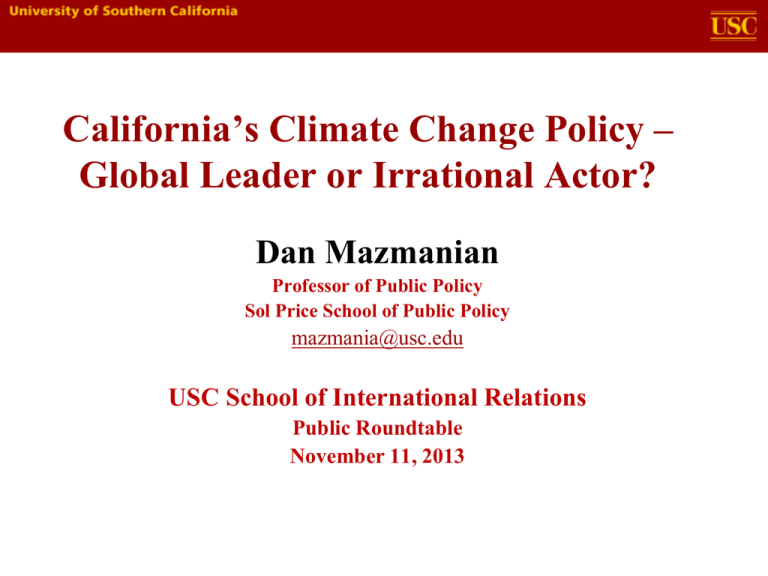
California’s Climate Change Policy – Global Leader or Irrational Actor? Dan Mazmanian Professor of Public Policy Sol Price School of Public Policy mazmania@usc.edu USC School of International Relations Public Roundtable November 11, 2013 Projected Global Warming: 2+ Degrees Celsius California’s Response to the IPCC Global Warming Challenge (Mitigation) AB32, “The California’s Global Warming Solutions Act of 2006” • The Act was passed by Democratic legislature and signed into law by a Republican Governor. • It is extraordinary in its comprehensive, economy-wide coverage calling for a multifaceted effort of greenhouse gas reductions by the business and people of California. • It calls for reducing GHG emissions to 1990 levels by 2020 (a 25% reduction in emissions). AB 32 Emissions Reduction Strategy Scoping Plan • • • • • • • • Cap-and Trade Program Light-Duty Vehicle GHG Standards Energy Efficiency Renewables Portfolio Standard Low Carbon Fuel Standard Regional TransportationRelated GHG Targets Vehicle Efficiency Measures Goods Movement • • • • • • • • • • Million Solar Roofs Program Medium/Heavy-Duty Vehicles Industrial Emissions High Speed Rail Green Building Strategy High Global Warming Potential Gases Recycling and Waste Sustainable Forests Water Agriculture Trends in CA GHG Emissions • Emissions per dollar of gross domestic product (GDP) dropped by 27% between 1997 and 2010. • Efficiency also improved with per capita emissions dropping 9% over the same time period. • Total GHG emissions continue to fall from their peak in 2008, decreasing 1.4 percent since 2009 to 451.6 million MTCO2e. • Emissions need to drop another 4% to reach 1990 levels. • While CA improves, total U.S. emissions rose 3.2 percent from 2009 to 2010 and have increased 10.5 percent since 1990. (NEXT 10, 2013 CA Greening Index; pp.17 &.20) CA Public Opinion: Strong Support • Two-thirds say global warming is a serious threat (48% very serious, 31% somewhat serious) to economy and quality of life in the future • Most (67%) favor the state law requiring CA to reduce greenhouse gas emissions • Most (65%) say steps need to be taken right away to counter the effects of global warming • 60% of Californians favor the state making its own policies, separate from the federal government • However, with Cap and Trade provisions 54% heard nothing. Of those who have heard a lot, strong support (62% - 35% in favor) (PPIC survey on environment, July 2013) Urban Policy Companion Legislation SB375, Sustainable Communities and Climate Protection Act of 2008 • The Act requires reductions in GHG and VMT (vehicles miles traveled) in exchange for expedited development permitting. • It calls for linking CA’s climate change strategy to future development through regional-based planning for transportation, jobs-housing balance, and urban design within the context of a growing state population. • Incentives: relief from some CEQA (CA Env. Quality Act) provisions; federal transportation funding California’s Response to the Projected Effects of Climate Change (Adaptation) Study the problem, develop an array of possible responses, yet no adaptation policy comparable to AB32 adopted by the state legislature and signed into law by the governor. Two state-level policy studies: 2009 – CA Natural Resources Agency, “California Climate Adaptation Strategy” (being updated for 2014): http://www.climatechange.ca.gov/adaptation/index.html 2010 – (CAAP) California Adaptation Advisory Panel Report, “Preparing for the effects of climate change – a strategy for California”:http://www.pacificcouncil.org/document.doc?id=185 (Note: I served as executive director of CAAP) SEA LEVEL RISE: Property at Risk FOREST AND RANGE LAND FIRE: Hotter, drier summers could result in longer more intense wild fire seasons. Source of fire slides: Anthony Westerling, 2009 WATER: The Snowpack in the High Sierra’s on which CA relies for up to 40% of its water storage capacity will be reduced by up to 80% Sierra Snowpack: Impact of Climate Change Lower Emissions Scenario (2070-2099) Historical Average (1961-1990) 100% Remaining Source: Scripps 2006 13 40% Remaining Higher Emissions Scenario (2070- 2099) 20% Remaining Perceptions of Threats Concern level Very high Somewhat Wildfires that are more severe Droughts that are more severe Increased flooding Storms that are more severe 57% 49 28 28 25% 29 28 30 (PPIC Survey, July 2013) •Aligning incentives at the level of the individual, business and industry, community, regional and state level to result Adaptation Actions Under Consideration as State Policy in CA 1. Enhanced data gathering and monitoring of climate change effects (underway) 2. Require intergovernmental and inter-sector coordination around climate change effects in planning and approving projects 3. Develop capacity at all levels of government in science-based climate change assessments and decision making 4. Develop extensive and continuous public education and on climate change and projected effects Cont.: 5. Establish a California Risk Council in the office of the governor (CAAP only) 6. Align incentives at the level of the individual, business and industry, community, regional and state level to result in adaptation actions (CAAP only) 7. Enact a 30-year, rolling “climate change compliance” requirement for all development and infrastructure activities The Puzzle of CA Acting Globally While Talking Locally Precedent setting state mitigation policy on the “collective good” dimension of the climate change challenge, of benefit to the 7 billion people on the planet, i.e., AB32. Inaction on the “selective good” dimension of direct benefit to the 38 million Californians, i.e., no comparable adaptation state policy on the needs of the state. A Provisional Explanation of the Puzzle John Kingdon’s three streams theory of policy adoption • Problem recognition • Available policy ‘solutions’ • Political timing [John Kingdon, Agendas, Alternatives, and Public Policies, 2003] Problem stream – Has a ‘condition’ been defined as a public policy ‘problem’? • Yes for mitigation: IPCC, UN Framework Convention on Climate Change; U.S. debate on carbon tax vs. cap-and-trade; CA’s AB32 • Nothing comparable for adaptation (although, the Weather Channel’s dramatization of extreme weather events and Hurricane Sandy nationally and the CA Energy Commission reports on CA’s vulnerabilities) Policy stream – Are there plausible policy responses waiting in the wings? • Yes for mitigation: IPCC GHG emissions reduction target for 2050; dovetailing of GHG reductions with local and state Clean Air goals; studies showing net jobs gains from green investment • Nothing comparable for adaptation: Absence of an IPCC or other goal or target for adaptation, e.g., requiring that all development and infrastructure be capable of withstanding a sea-level rise, of 1 -2 meters Political stream – Is the convergence of political forces sufficient to place the problem on the political agenda? • Yes for mitigation: a Governor willing to champion and expend political capital and a legislature sympathetic to the environmental community • No for adaptation… at least not yet • Proposed legislation on hold in the legislature • Silence on the part of the governor • The shifting political winds and partisan gridlock in the U.S. between 2006 versus 2013 Selected papers on climate change Daniel Mazmanian, John Jurewitz, & Hal Nelson (forthcoming), “A Governing Framework for Climate Change Adaptation for the Built Environment,” Symposium on Governing Adaptation, ECOLOGY AND SOCIETY. Daniel A. Mazmanian, Hal T. Nelson, & John Jurewitz (2013), “Climate Change Policy: A Race to the Top,” Ch. 16 in GOVERNING CALIFORNIA: POLITICS, GOVERNMENT AND PUBLIC POLICY IN THE GOLDEN STATE, 3rd Edition, Berkeley Public Policy Press, University of California, Berkeley. Daniel A. Mazmanian, John Jurewitz, & Hal T. Nelson (2013), “The Paradox of ‘Acting Globally While Thinking Locally’: Discordance in Climate Change Adaptation Policy Formation”, JOURNAL OF ENVIRONMENT & DEVELOPMENT, 22(2): 186-206. Daniel Mazmanian, John Jurewitz, & Hal Nelson (2008), “California’s Climate Change Policy: The Case of a Subnational State Actor Tackling a Global Challenge,” JOURNAL OF ENVIRONMENT AND DEVELOPMENT, Vol. 14, No.4.

